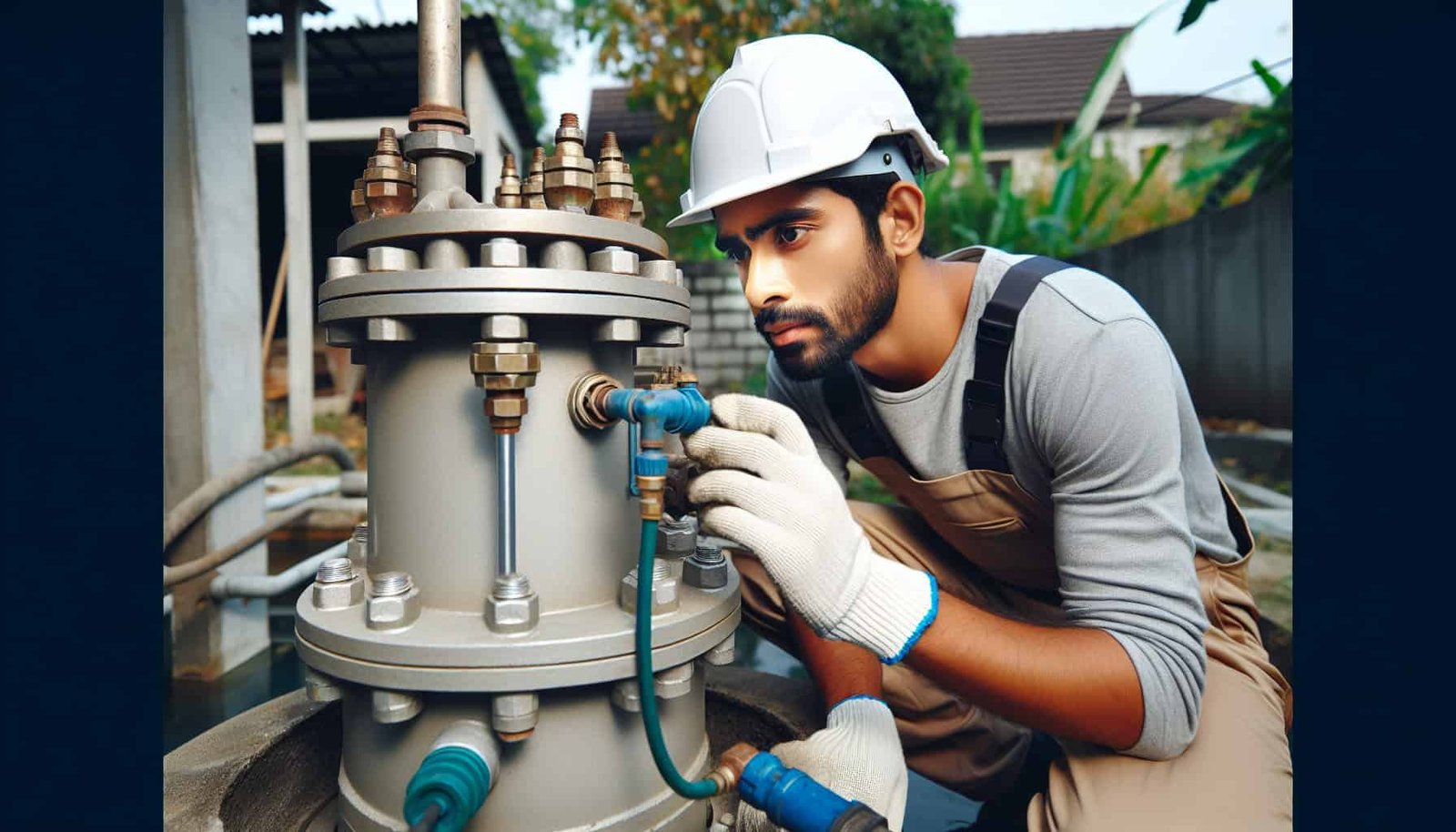If you rely on well water for your household needs and live in an area with a well water pressure tank maintenance plan, it is essential to be aware of the safety considerations that come with it. Maintaining a clean and safe water supply is crucial for the health and well-being of your family. In this article, we will explore the safety measures and precautions to take when dealing with well water in regions with well water pressure tank maintenance plans. From regular testing and inspections to understanding potential contaminants, this guide will help you ensure that your well water remains safe and healthy.
Potential Contamination Sources
Surrounding Environment
The surrounding environment can pose potential risks to well water contamination. Various factors, such as nearby sources of pollution, flooding, and geological features, can affect the safety of well water. It is important to assess the proximity of potential contamination sources, such as landfills or industrial activities, and their potential impact on the well water quality.
Agricultural Activities
Agricultural activities, including the use of pesticides, fertilizers, and livestock waste, can introduce contaminants to groundwater. Runoff from fields and improper management of agricultural activities can lead to the contamination of well water. Well owners in agricultural areas should be mindful of these potential risks and take necessary measures to protect their water.
Industrial Pollution
Industries can contribute to water pollution through improper waste disposal practices or accidental spills. The discharge of chemicals, heavy metals, or other pollutants can infiltrate groundwater and contaminate wells in the vicinity. Monitoring surrounding industrial activities and following local regulations can help minimize the risk of industrial pollution on well water.
Septic Systems
Properly functioning septic systems are crucial in preventing contamination of well water. Malfunctioning or poorly maintained septic systems can leak harmful pathogens and pollutants into the groundwater, posing a significant health risk. Regular septic system inspections and maintenance are vital to ensure the protection of well water quality.
Chemical Storage Facilities
Chemical storage facilities, such as those found in industrial areas or agricultural operations, can be potential sources of water contamination. Leaks or spills from these facilities can introduce hazardous substances into groundwater. Implementing proper storage and handling practices, along with regular inspections, can help mitigate the risk of contamination from chemical storage facilities.
Water Testing and Analysis
Regular Testing
Regular testing of well water is essential to ensure its safety and identify any potential contaminants. Testing should be conducted at appropriate intervals to monitor water quality accurately. It is recommended to test for a range of parameters, including microbiological contaminants, chemicals, and physical properties, to have a comprehensive understanding of the water’s safety.
Microbiological Testing
Microbiological testing involves analyzing well water samples for the presence of potentially harmful bacteria, viruses, and parasites. This testing helps to identify pathogens that can cause waterborne illnesses. Ensuring the absence of bacteria such as E. coli and other harmful microorganisms is crucial to maintaining the safety of well water.
Chemical Analysis
Chemical analysis aims to assess the presence of various contaminants in well water, such as heavy metals, pesticides, fertilizers, and industrial chemicals. Regular monitoring of chemical parameters helps detect any changes and potential sources of pollution. Understanding the chemical composition of well water is crucial for ensuring its safety and preventing health risks.
Interpretation of Test Results
Interpreting water test results can be complex, as it requires understanding the significance of different parameters and their associated health risks. Well owners should seek professional guidance or refer to established guidelines provided by local health authorities. Understanding the test results allows well owners to take appropriate actions to maintain and improve water quality.

Preventing Contamination
Regular Well Inspections
Regular well inspections are crucial to identify any potential issues or vulnerabilities that could lead to water contamination. These inspections include assessing the structural integrity of the well, checking for signs of damage or wear, and ensuring proper sealing and protective measures are in place. Well owners should consider scheduling inspections by qualified professionals at recommended intervals.
Protective Well Caps
Well caps play a vital role in preventing surface contaminants from entering the well. A properly fitted and secure well cap prevents the entry of insects, small animals, and debris that could contaminate the water. Well owners should ensure that their well caps are in good condition, properly sealed, and meet local regulations for well protection.
Location Considerations
The location of a well can significantly impact water quality. Well owners should choose a location that minimizes potential contamination risks. It is advisable to position wells uphill and away from potential pollution sources like septic systems, agricultural fields, or industrial activities. Consulting local experts or regulatory agencies can provide guidance on suitable well locations.
Well Depth and Construction
The depth and construction of a well can affect its vulnerability to contamination. Proper construction techniques, such as sealed casing and grouted annular space, ensure that surface contaminants do not infiltrate the well. The depth of a well can also determine the level of protection against contamination. Well owners should consult professionals to determine the appropriate well depth and construction methods for their specific location.
Well Maintenance
Regular maintenance of wells is essential for preventing contamination and ensuring the longevity of the system. Well owners should be proactive in maintaining their wells, including activities such as cleaning and disinfecting the well, testing the pump and pressure system, and repairing any leaks or damages promptly. Following a well maintenance schedule and seeking professional guidance when needed will help optimize water quality and system performance.
Disinfection and Treatment
Chlorination
Chlorination is a commonly used method to disinfect well water and eliminate bacteria and other harmful microorganisms. Chlorine is added to the well water in controlled amounts to ensure effective disinfection while maintaining safety for consumption. Well owners should consult professionals to determine the appropriate chlorine dosage and ensure proper chlorination processes are followed.
UV Treatment
Ultraviolet (UV) treatment is an alternative disinfection method that utilizes UV light to neutralize harmful bacteria, viruses, and parasites in well water. UV treatment systems are installed at the point of entry to the water system and effectively destroy microorganisms without adding any chemicals to the water. Well owners should consider UV treatment as an additional layer of protection against waterborne pathogens.
Filtration Systems
Filtration systems are commonly used to remove physical particles, sediments, and certain chemicals from well water. There are various types of filtration systems available, including sediment filters, activated carbon filters, and reverse osmosis systems. Well owners should assess the specific needs of their water and seek professional advice to choose the appropriate filtration system for their well.
Activated Carbon Filters
Activated carbon filters are particularly effective in removing organic compounds, chlorine, and certain chemicals from well water. These filters work by adsorbing the contaminants onto the porous surface of the carbon. Well owners should consider incorporating activated carbon filters into their treatment system to improve taste and odor and to reduce chemical exposure in their well water.

Well Water Pressure Tank Maintenance
Importance of Maintenance
Regular maintenance of well water pressure tanks is essential for ensuring the proper functioning and longevity of the system. Well water pressure tanks play a crucial role in maintaining consistent water pressure and extending the lifespan of the well pump. By properly maintaining the pressure tank, well owners can avoid costly repairs and ensure a continuous supply of water.
Schedule and Frequency
The maintenance schedule for well water pressure tanks may vary depending on factors such as the tank’s size, usage, and water quality. It is generally recommended to inspect the pressure tank annually and perform necessary maintenance tasks, such as checking for leaks and monitoring pressure levels. Well owners should refer to the manufacturer’s recommendations or seek professional advice for the appropriate maintenance frequency.
Inspecting for Leaks
Regular inspection for leaks is vital to prevent water damage and system inefficiency. Well owners should visually inspect the pressure tank, connections, and associated pipes for any signs of leakage. Common indicators of leaks include water puddles, dampness, or corrosion around the tank or fittings. Prompt identification and repair of leaks will help maintain system performance and prevent further damage.
Checking Pressure Levels
Monitoring pressure levels in the well water pressure tank is essential to ensure adequate water supply and prevent system issues. A pressure gauge connected to the tank displays the pressure levels. Well owners should periodically check the gauge to ensure the pressure is within the recommended range. Fluctuations or abnormal pressure readings may indicate a problem that requires attention.
Cleaning and Flushing
Regularly cleaning and flushing the well water pressure tank helps remove sediment, residue, and mineral buildup that can affect system performance. Well owners should follow manufacturer guidelines for cleaning procedures or consult professionals for assistance. Flushing the tank periodically can help improve water quality and maintain the efficiency of the pressure tank.
Managing Water Pressure Fluctuations
Pressure Relief Valves
Pressure relief valves are crucial components in managing water pressure fluctuations and protecting the well system. These valves open automatically to release excess pressure, preventing damage to the pressure tank and associated plumbing. Well owners should ensure that pressure relief valves are installed correctly, regularly inspected, and compatible with the system’s specifications.
Water Hammer Arrestors
Water hammer occurs when water flow in the pipes suddenly stops or changes direction, leading to loud banging noises and potentially damaging the well system. Water hammer arrestors are devices installed in the plumbing system to absorb the shock caused by water hammer, preventing damage and extending the system’s lifespan. Well owners should consider installing water hammer arrestors to mitigate the effects of pressure fluctuations.
Pressure Tanks Installation
Proper installation of pressure tanks is crucial for managing water pressure fluctuations. Well owners should consult professionals to determine the appropriate size and location for the pressure tank. Installing the tank near the well and following manufacturer guidelines will help ensure the system operates efficiently and withstands pressure changes effectively.
Adjusting Pressure Switches
The pressure switch in a well system controls the operation of the well pump based on preset pressure parameters. Adjusting the pressure switch settings can help manage pressure fluctuations and optimize system performance. Well owners should exercise caution when adjusting pressure switches and consider seeking professional assistance to ensure the settings align with the well’s specifications.
Effects of Pressure Fluctuations
Uncontrolled pressure fluctuations can lead to various issues, such as water hammer, damage to the well pump, or premature failure of the system components. Sudden changes in water pressure can also cause faucets to malfunction or pipes to burst. Well owners should adopt measures to manage pressure fluctuations adequately and protect the well system from potential damage.

Protecting Against Physical Hazards
Well Casing Security
Securing the well casing is crucial to prevent unauthorized access and physical damage to the well. Well owners should regularly inspect the casing to ensure it is intact, free from cracks or damage, and properly sealed. Reinforcing the security of the well casing will help prevent contamination risks and safeguard the water supply.
Avoiding Chemical Contamination
Well owners must take precautions to avoid introducing chemicals into their well water. Practices such as storing chemicals away from the well, using non-toxic cleaning products, and avoiding the disposal of hazardous substances down drains or sinks are essential. By implementing safe handling and storage practices, well owners can prevent chemical contamination of their well water.
Protection from Flooding
Flooding can pose a severe risk to wells, leading to the infiltration of contaminants and potentially causing damage to the well system. Well owners should ensure that their wells are located on higher ground and take appropriate measures to protect the well from floodwaters. Installing a well cap that forms a watertight seal and raising the wellhead above flood levels are recommended precautions.
Sealing Unused Wells
Unused wells can pose significant safety risks, including the potential for contamination and accidents. Well owners should consider sealing unused wells with appropriate methods, such as filling them with sealing materials or installing proper well caps. Consulting professionals or local authorities can provide guidance on the specific requirements and regulations for sealing unused wells.
Vermin and Pest Control
Vermin and pests, such as rodents or insects, can cause damage to well systems and introduce contaminants to well water. Well owners should take measures to prevent the entry of vermin into the well area, such as sealing any access points, keeping the surroundings clean, and removing potential food sources. Regular monitoring and pest control measures can help ensure the integrity and safety of the well.
Emergency Preparedness
Backup Power Sources
Maintaining a reliable backup power source is essential for well owners to ensure a continuous supply of water during power outages. Backup generators or battery systems can be used to power the well pump and keep the water flowing. Well owners should consider their specific needs and consult professionals to determine the appropriate backup power source for their well system.
Water Storage Options
Having sufficient water storage capacity is vital during times of emergency or when the well is inaccessible. Well owners should explore water storage options, such as large storage tanks or barrels, to store an adequate supply of water. It is recommended to store enough water to sustain all household needs for at least three days.
Water Treatment During Power Outages
During power outages, the regular water treatment systems may not function, potentially compromising the safety of well water. Well owners should consider alternative methods for water treatment, such as boiling, disinfecting with chlorine or iodine, or utilizing portable water filters. Understanding these emergency water treatment methods will help ensure access to safe drinking water during unforeseen circumstances.
Emergency Response Plan
Developing an emergency response plan specific to the well system is crucial for preparedness. Well owners should create a plan that includes steps to take during power outages, contamination incidents, or natural disasters. The plan should outline contact information for professionals, local authorities, and emergency response agencies, ensuring prompt communication and appropriate actions during emergencies.
Contacting Local Authorities
In the event of a suspected water contamination incident or any emergency related to the well system, well owners should contact local health departments or environmental agencies. These authorities can provide valuable guidance, support, and resources to address the situation effectively. Prompt communication with the authorities is essential for protecting public health and ensuring appropriate actions are taken.

Educating Well Owners
Awareness of Potential Risks
Promoting awareness of potential risks associated with well water is crucial for well owners. Educating well owners about the sources of contamination, health risks, and preventive measures will help them make informed decisions and take appropriate actions to safeguard their well water. Well owners should stay informed about local water quality issues and participate in educational initiatives to enhance their knowledge.
Safety Guidelines and Best Practices
Providing well owners with safety guidelines and best practices is essential for maintaining the integrity of well water. These guidelines can include information on well construction, proper maintenance, testing frequency, and recommended treatment options. Distributing educational materials or organizing workshops will help disseminate important information and empower well owners with the knowledge to protect their water.
Signs of Contamination
Educating well owners about the signs of water contamination is paramount to ensure prompt action when necessary. Common signs of contamination include changes in water color, odor, taste, or the presence of sediment. Well owners should be encouraged to regularly inspect and monitor their well water and seek professional assistance if any signs of contamination are observed.
Resources for Information
Well owners should have access to accurate and reliable resources for information on well water safety. Local health departments, environmental agencies, and water testing laboratories can be valuable sources of information. Well owners can also utilize online platforms, publications, and community resources to stay up to date with the latest practices and guidelines for maintaining safe well water.
Community Engagement
Promoting community engagement and collaboration is crucial for enhancing well water safety. Well owners can participate in community programs, workshops, or local committees focused on well water protection. Sharing experiences, knowledge, and best practices within the community fosters a culture of responsibility and collective efforts towards ensuring the safety of well water.
Complying with Regulatory Standards
Legal Requirements
Different jurisdictions may have specific legal requirements concerning well water. Well owners should familiarize themselves with the laws and regulations applicable to their region. This may include obtaining permits for well construction, meeting water quality standards, and complying with reporting and documentation requirements. Complying with legal requirements is essential for maintaining the safety and legality of the well system.
Water Quality Standards
Water quality standards establish the acceptable limits for various contaminants in well water. Well owners should be aware of the specific standards set by relevant regulatory agencies. Monitoring well water regularly and comparing test results to the established standards will help ensure compliance and identify any potential issues that require attention.
Reporting and Documentation
Well owners may be required to report specific information or maintain documentation related to their well systems. This may include reporting well construction details, test results, maintenance records, or any incidents of water contamination. Well owners should adhere to the reporting and documentation requirements set by local regulatory agencies to demonstrate compliance and ensure transparency.
Permits and Inspections
Obtaining the necessary permits and undergoing inspections are common requirements for well owners. These permits and inspections help ensure that the well system meets the necessary safety and regulatory standards. Well owners should familiarize themselves with the requirements specific to their region and engage with qualified professionals to assist them in obtaining permits and scheduling inspections.
Understanding Local Regulations
Understanding and complying with local regulations is crucial for well owners to maintain the safety and legal compliance of their well systems. Well owners should proactively seek information on local regulations governing well water, such as setback distances, well construction codes, or restrictions on certain activities. Staying informed about local regulations helps prevent potential violations and ensures the long-term viability of the well system.
In conclusion, ensuring the safety of well water involves multiple considerations, ranging from preventing contamination sources, conducting regular testing and analysis, implementing preventive measures, and adhering to regulatory standards. By following the guidelines and best practices outlined in this article, well owners can safeguard their water supply, protect public health, and contribute to the overall well-being of their communities.

